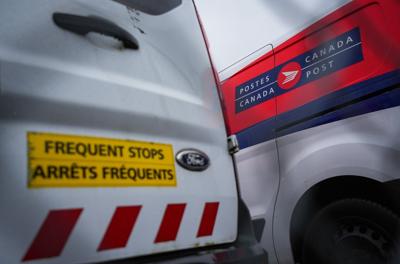As Canada Post workers began a “strike action” Friday that will see them stay on the job while refusing overtime work, the federal government urged the Crown corporation and its employees to get back to the bargaining table, and suggested using a mediator’s report issued last week as a model.
Friday morning, federal jobs minister Patty Hajdu posted on X that the Canadian Union of Postal Workers (CUPW) and the Crown corporation should use a report delivered by veteran mediator William Kaplan to reach a negotiated settlement.
“I expect Canada Post and CUPW¬†to continue their efforts at the bargaining table to reach lasting deals that restore stability to our postal service while protecting its vitality today and tomorrow,” Hajdu wrote. ”The¬†Industrial Inquiry Commission‚Äôs report offers clear advice to achieve that. Now it‚Äôs time for the parties to put in the work and make it happen.”
Friday afternoon, Canada Post said in a written statement that it still hadn’t received an official response to a contract offer it presented to the union Wednesday, but that it was ready to resume bargaining at any time.
“We are ready to return to the table as soon as possible, with the assistance of the mediator. At this time, there are no talks scheduled but we have booked space over the weekend so we can reconvene quickly if we hear from CUPW,” Canada Post said, adding that parcel volumes have dropped substantially since the union issued a 72-hour strike notice earlier this week.
“The threat of a strike has already had a significant impact on Canada Post as customers have either moved to other delivery providers or have cancelled mailings to avoid their items being trapped by another disruption,” the Crown corporation said. “Since receiving the 72-hour strike notice from CUPW on Monday, we have delivered approximately 50 per cent or 1.3 million less parcels when compared to the same period in 2024.”
Late Thursday night, CUPW announced that its members would be refusing overtime work beginning at midnight local time across the country, rather than walking off the job entirely.
‚ÄúWhile this action does constitute a continuation of our strike activity, postal workers will remain on the job to minimize disruption to the public,‚ÄĚ CUPW said in a written statement.
Labour relations experts say the Crown corporation and union both likely realize CUPW doesn’t have enough external leverage or membership support to make a full-blown strike effective.
“Public opinion plays much more of a role in these types of national strikes than a shoe factory, or even an auto plant,‚ÄĚ said Rafael Gomez, director of the University of Toronto’s Centre for Industrial Relations and Human Resources. “Canada Post is playing some hardball because timing doesn‚Äôt favour the union, and public sentiment really doesn’t either.”
Gomez suggested that the union is likely looking for any small improvement over a contract offer made by Canada Post on Wednesday, so they can say to their members that they’ve added value.
“I think they need to be able to show that this strike action actually got them something over the offer. Even if it’s not much,” Gomez said.
Wednesday‚Äôs four-year contract offer includes the creation of new, part-time and temporary carrier job categories to help Canada Post extend parcel delivery to weekends, as well as the use of ‚Äúdynamic routing‚ÄĚ at 10 mail-sorting facilities. Dynamic routing means carriers could see their routes shift daily to accommodate changes in volume.
Canada Post said the offer also includes total wage increases of 13 per cent for existing employees, with a six per cent increase in the first year, followed by increases of three, two and two per cent.
The federal government also realizes that public opinion isn’t on the union’s side, and would be quick to intervene in the event of a full-blown strike, suggested Stephanie Ross, a professor of labour relations at McMaster University.
“Kaplan’s report gave the government plenty of cover to intervene if they want to,” said Ross, noting that Prime Minister Mark Carney is seen as less labour-friendly than his predecessor, Justin Trudeau. The trade war sparked by tariffs from U.S. President Donald Trump is also limiting political and public patience for a broad strike like the 32-day walkout last November and December, Ross argued.
“Government intervention might be more rapid this time around. This is not something Carney wants to be distracted with, given the larger political and economic pressures he‚Äôs trying to navigate,” Ross said.
Kaplan’s report said Canada Post was effectively insolvent and suggested the use of community mailboxes, the elimination of home delivery except for parcels, and getting rid of some post office locations and replacing them with franchises.
Kaplan also suggested expanding parcel delivery to seven days a week, with the use of part-time and temporary employees.
Kaplan was also pessimistic about the prospect of a negotiated settlement between the two sides, and added that binding arbitration was also not likely to provide a lasting solution. Kaplan also noted a third possibility¬†‚ÄĒ of Canada Post asking the federal government to force a vote on a ‚Äúfinal offer.‚ÄĚ
He delivered the official report from his Industrial Inquiry Commission to the federal government, including Hajdu, last week.
In December, Kaplan was appointed to run the commission by then-federal labour minister Steven MacKinnon.
At the same time, MacKinnon asked the Canada Industrial Relations Board (CIRB) to declare an impasse in contract talks. The CIRB did just that, and workers were ordered back on the job Dec. 17, temporarily pausing a month-long strike.
Kaplan was given a dual mandate, both to chart a path for Canada Post’s future structure and mandate, and to suggest the foundations of a potential new contract agreement.
More to come.




























To join the conversation set a first and last name in your user profile.
Sign in or register for free to join the Conversation